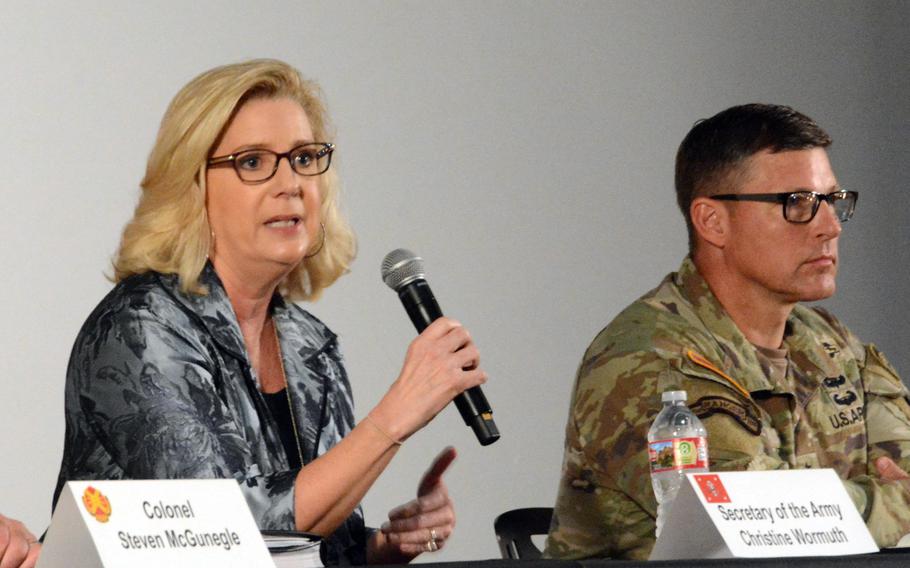
Secretary of the Army Christine Wormuth speaks during a town hall meeting at Schofield Barracks, Hawaii, Tuesday, Jan. 24, 2023, while seated beside Maj. Gen. Joseph Ryan, commander of the 25th Infantry Division. (Wyatt Olson/Stars and Stripes)
SCHOFIELD BARRACKS, Hawaii – Secretary of the Army Christine Wormuth arrived in Hawaii on Sunday evening to get a firsthand look at the deteriorating condition of the service’s buildings, particularly barracks.
“So, I was able to see some of the barracks at Schofield,” she told reporters Tuesday afternoon at Schofield Barracks on Oahu, shortly before holding a town hall meeting in the base’s movie theater as part of her four-day visit.
“They took me into one of the basically what we call a Q4 barrack, which is our least hospitable barrack, I think it's fair to say, and I wasn't happy with what I saw, frankly,” she said. “Those are the kinds of things that I want us to get after.”
A Q4-rated barrack is one that fails to meet minimum standards but for which the cost of improvements exceeds 40% of the cost of replacing it.
Flagging infrastructure is an Army-wide problem, but the issue is especially acute in Hawaii.
A Congressional Budget Office report issued in November found that the Army would need to spend $34 billion to renovate and modernize aging buildings on its bases, with a quarter of that alone going to upgrade structures in Hawaii and on Fort Bragg, N.C.
Army structures in Hawaii — at Schofield Barracks, Fort Shafter and Tripler Army Medical Center — and at Fort Bragg accounted for a “significantly larger” share of both deferred maintenance and upgrade cost estimates as compared to other locations, the report said.
Deferred maintenance is work that the Army has determined is needed to meet its mission goals but has not been carried out.
Based on 2020 figures provided by the Army, the CBO estimated it would cost $4 billion to complete deferred maintenance and renovate Army structures in Hawaii.
The price tag for such work at Fort Bragg was even higher at an estimated $8.4 billion.
The consequence of delayed maintenance made headlines in August when hundreds of Fort Bragg soldiers were forced to move from barracks because of persistent mold fostered by dilapidated air conditioning systems.
During the town hall meeting, which was livestreamed, a viewer named Jordan submitted a written question asking about the Army’s plan for improvements.
“There are ongoing electric and water issues,” he wrote. “Facilities need to be updated. Our kids’ schools can't keep the power on. Gyms and other buildings have roofs that leak.”
Wormuth said Gen. Edward Daly, commander of U.S. Army Materiel Command, had recently brought a team to Hawaii to conduct assessments of the infrastructure.
Officials from the Army’s Installations, Energy and Environment Office have also sent a team to do the same, she said.
The results of those assessments have been presented to Gen. Charles Flynn, commander of U.S. Army Pacific, and in February Flynn is slated to brief Wormuth and Gen. James McConville, Army chief of staff, she said.
“And that will be an input into our decision-making about what investments, what further investments, we make beyond what is already the five-year Army budget to get after infrastructure issues,” she said.
A soldier in the audience, noting that mold has been a decades-long problem, wanted to know what the Army’s plan was right now to deal with that hazard.
“The Army is spending about $1 billion a year on new barracks, and we're going to be doing at least that for the next 10 years to try to make sure that we are building new barracks that are designed to be around and to be livable for 40 years or more,” Wormuth said.
Funding, however, is finite, and the challenge for her and McConville is prioritizing needs, she said.
“How do we weigh, essentially, buying a new child development center, for example, against money that we are spending towards developing our new weapons systems, which are also very, very important as we transform to the Army of 2030?” Wormuth asked.
“Because we don't have enough money to solve every single problem right away,” she said.